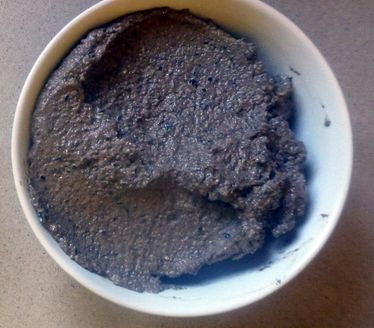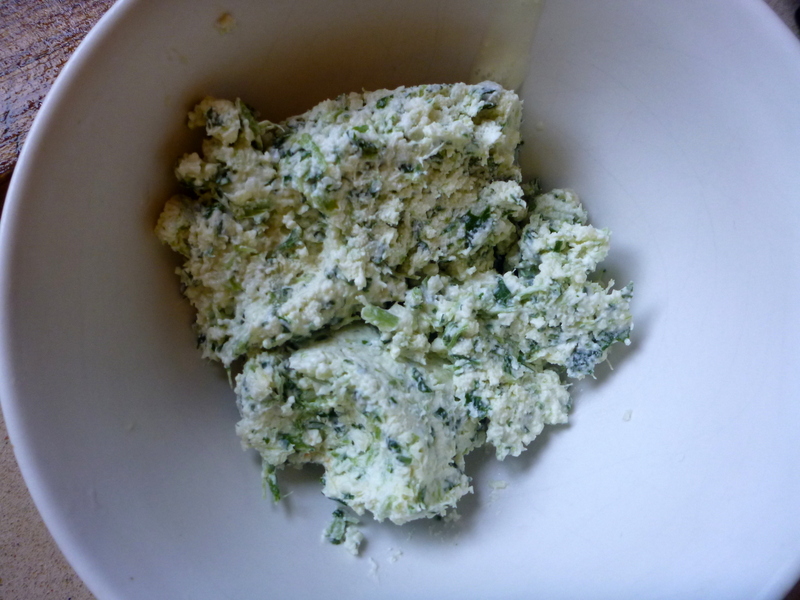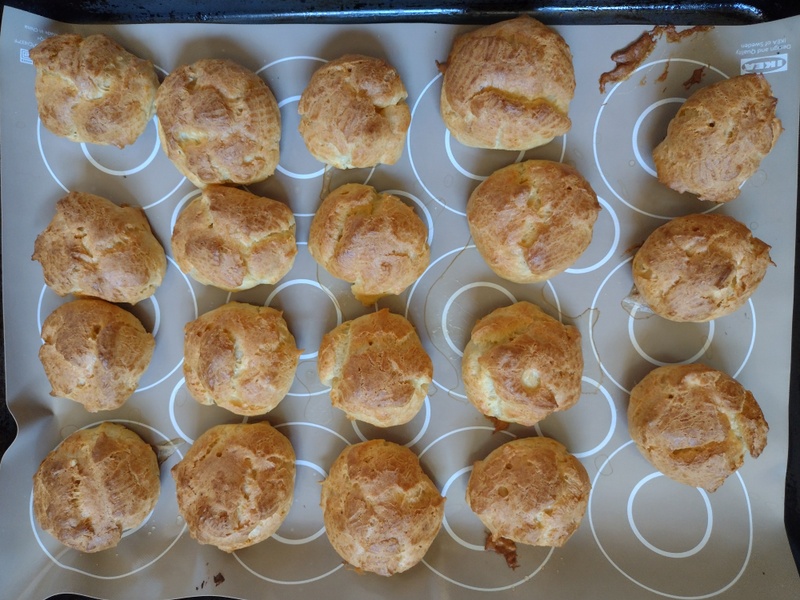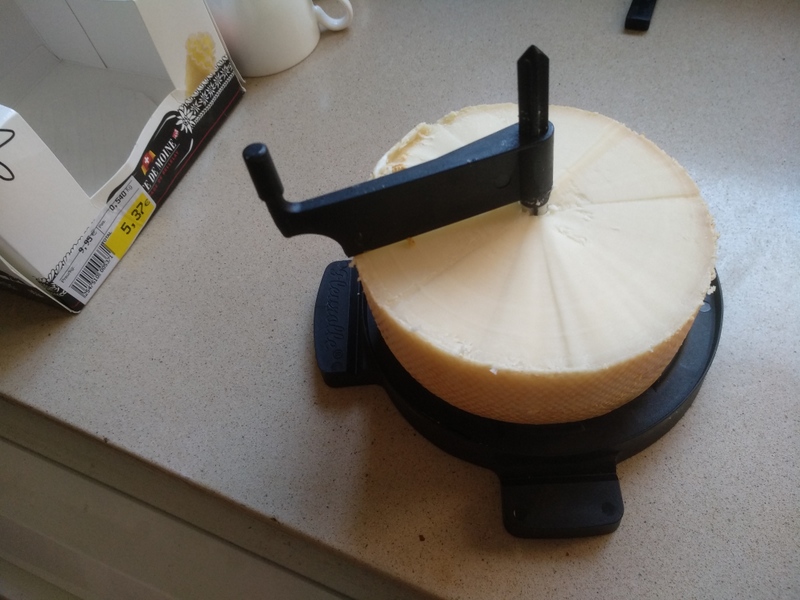
Olivada
picar olives negres, oli i pebre
Amb nous:

Olivada
picar olives negres, oli i pebre
Amb nous:

Crema de gingebre (versió casolana del horseradish cream): es pica mig gingebre amb un parell de grans d’all i un quart de ceba; es barreja amb un iogur i un formatge filadelfia (hi vaig posar crema però no se’m va muntar), es deixa a la nevera en un colador per que vagi escorrent-se el líquid que es podrà aprofitar per fer alguna vinagreta. Cibulet.
• Dips: 1 cup yogurt (drain through a cheesecloth-lined sieve for 30 minutes in the refrigerator for a thicker texture)
.• Dips: 1 cup cottage cheese plus 1/4 cup yogurt or buttermilk, briefly whirled in a blender.•
Dips: 6 ounces cream cheese plus 3 tablespoons milk, briefly whirled in a blender.

100 g mantega a dissoldre en 250ml d’aigua i una mica de sal. 150g de farina i es remena fins que queda una pasta. Es deixa atemperar. S’afegeixen 4 ous batuts, un a un i al final una cullera de sopa de sucre. Es posa mb la mànega pastissera (si és prou gran) i 45m al forn a 180º i 15m més a 160º.
Back to basics: How to make a perfect choux pastry
farcits: mousse + nata + trossos de fruita
farcits salats?: crema de bròquil
Desfer la mantega en un pot al foc, amb l’aigua, la llet, la sal i el sucre. Quan comença a bullir, treure del foc i afegir-hi la farina tot barrejant. Quan la farina hagi absorbit tota la mantega tornar a posar al foc uns 3 min. Deixar refredar la pasta. Afegir-hi els ous remenant poc a poc. Ha de quedar una pasta consistent. Fer unes boles [com de lionesa] i posar a un plata de forn [amb l’argolla de motlle?]. Reservar-ne una mica. Pulveritzar amb aigua per que quedi més humit.
Al forn a 190º entre 30 i 40min. Al cap de 25min punxar amb un palillo. Deixar al forn 5 o 10 min més fins que estiguin daurats. Deixar re fredar i desar en un recipient tancat o congelar.
[Amb la mida d’un motlle petit de galeta queden lioneses bastant grosses]

Napolitana o Margheritta: Tomàquets (San Marzano) + mozzarela di buffala + aufàbrega i un raig d’oli [ adaptació: tomàquets pera triturats, mozarella bufala de Bonàrea]
Marinara: Salsa marinara, pomodoro, aglio (xafats), origano e olio extravergine di oliva
Capricciosa: mozzarela, pernil cuit, bolets, carxofes
Pugliese: Tomàquet, mozzarela i ceba

Base de pasta de full amb poma, salmó i nous (recepta Teresa)
Comprar formatges:
http://www.mundoquesos.com/2011/04/blau-del-net.html
Matons i brossats: recuit d’ovella o cabra (Mas Marcè)
Drap Herbacol. Ripollès
CABRA
Formatges durs de cabra (sant Gil d’Albió)
http://www.gastroteca.cat/ca/fitxa-oncomprar/formatges_veciana/ VEciana Anoia
Garrotxa Bauma, http://www.mundoquesos.com/search?q=garrotxa+bauma
Formatges tous de cabra (Mas Alba) Cuirol rodó, de Formatgeria Cuirols, La Nou del Berguedà. Pasta tova làctica de llet crua de cabra alpina i de pell florida. 50% de matèria greixosa i de 3 a 4 mesos de maduració. Es tracta d’un formatge potent però delicat a la vegada. Intenses notes làctiques de llet crua de cabra i de nata. Dens al paladar i molt llaminer. Un formatge elegant però contundent.
VACA
Tous de vaca: Sant Ignasi, de Formatgeria Reixagó (Olost, Lluçanès)
Formatge elaborat amb llet crua de vaca, de dues a tres setmanes de maduració, de pasta tova i pell florida. De textura molt cremosa, es fon al paladar deixant-lo ple d’aromes làctiques i sabor suau. Una delícia.
Tou Til·lers. Pallars Sobirà: http://www.mundoquesos.com/search?q=tou+til%C2%B7Lers
OVELLA
Formatges blaus [ovella, semi dur]
Blau el nét, el pla d’Urgell, (Hotel ) http://www.mundoquesos.com/2011/04/blau-del-net.html
Tous d’ovella: El Tou madurat amb fongs de Formatgeria Casa Mateu (Surp, Pallars Subirà) Formatge elaborat amb llet crua d’ovella, de pasta tova i pell florida. Amb un 40% de matèria greixosa. Formatge de textura fonedissa i aromes de bolets, amb una intensitat de sabors làctics provinents de la llet d’ovella que es combinen amb notes salines i un final lleugerament picant. No deixa indiferent.
Serrats d’ovella
Tupins: formatge sec i aiguardent, doble fermentació
Le Gruyère
Emmentaler (amb forats)
Tête de Moine: (amb la girolle es van arrencant encenalls fins)

Appenzeller: més sec, herbes
Sbrinz: molt dur
En un bol, poar-hi oli, sal, pebre, una cullerada de mel (passada pel microones) i una cullerada de soja